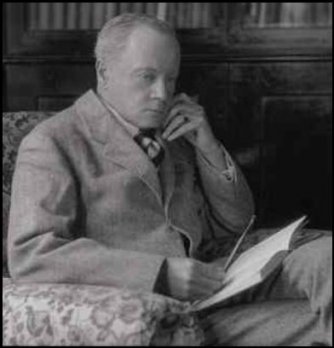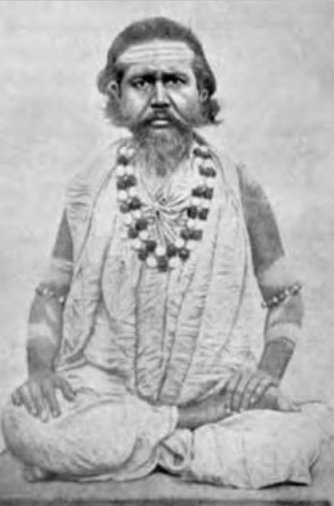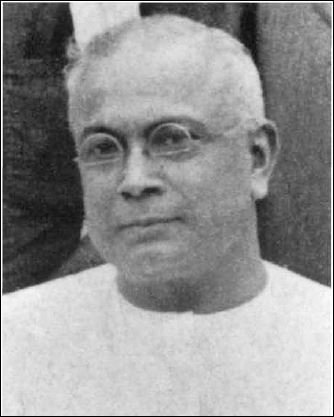| Library / Biographies |
Sir John George Woodroffe / Arthur Avalon Biography
For the one thing that strikes a close reader of his exposition is that he is truly an Indian Soul in a European body ... (M.P. Pandit: A Commentary on Sir John Woodroffe's: The Serpent Power)
1865
John George Woodroffe is born in Calcutta on 15 December 1865 to James Tisdall Woodroffe and Florence Hume and baptized at St. Peter's Anglican Church in January 1866. Three brothers and three sisters were born after him.

John Woodroffe, 1928. Portrait by Lafayette. (Wikipedia) His father, James Tisdall Woodroffe, was a very successful and wealthy barrister of the High Court. Between 1899 and 1904 he was Advocate General of Bengal, and a member of the Viceroy's Council.
John’s mother was born in India in a family who had lived in India for several generations. Her father, James Hume, was Presidency Magistrate of Calcutta and a cousin of Alan Octavian Hume, one of the founding members of the Indian National Congress.
1875
Parents convert to Roman Catholicism
1878
John and his brother Francis are sent to Woburn Park, a Catholic public school near Weybridge in Surrey.
1884
Starts attending University College Oxford, and studies for the Bachelor's Degree in Law, when the famous philologist and orientalist Max Müller was a prominent personality at Oxford around that time.
1888
John Woodroffe obtains the Bachelor of Civil Law degree and one year later joins his father at the Calcutta Bar where he soon proves himself as an expert on Indian Law.
1894
John’s mother dies at the age of forty-eight.
1897
He is made a Fellow of the Calcutta University and appointed Tagore Law Professor.
1898
In collaboration with Sir Sayeed Ameer Ali, a senior Indian judge (and an Indian Muslim nationalist) Woodroffe writes “The Law of Evidence”, regarded as an authoritative textbook that remained in print for a very long time.
1902
Woodroffe is appointed Standing Counsel to the Government of India.
Marries Ellen Elizabeth Grimson, 25, a concert pianist. She never been to India before marriage. John and Ellen shared a love for classical music and were attracted to Indian philosophy. Like many artists of the day, Ellen was interested in Theosophy.
1903
His lecture as Tagore Law Professor delivered at the University of Calcutta in 1897, “The Law Relating to Receivers in British India” is published at Thacker, Spink & Co., Calcutta.
1904
John is promoted to the High Court, the highest judicial administrative body in the state.
Haridev Śāstri, the Sanskrit interpreter of the High Court introduces Woodroffe to his guru, Śivacandra Vidyārṇava, a tantric saint.
James Tisdall Woodroffe retires from India.

Śivacandra Vidyārṇava
1906
Woodroffe makes a visit to Śivacandra’s ashram in Benares and based on descriptions, receives the highest form of initiation – the direct transmission of a state of mystical awareness from guru to disciple.
But as Woodroffe still doubts whether Śivacandra is the right guru for him, Śivacandra tells him to go and search for other gurus. Accompanied by Haridev Śāstri he meets yogis at Rishikesh, Hardwar, Guptakashi and Darjeeling. Each one tells him that his true guru is Śivacandra. His doubts are dispelled and despite his high social status, he becomes a humbled and devoted disciple.
John and his wife are initiated (krama) into the tantric rituals, as recorded in his guru biography. Later, the second initiation (mahāsamrāj abhiśekha) was performed by a woman, Jayakāli Devi, also a Guru of Atal Bihari Ghose.
His friend Ameer Ali recounts that “it was Woodroffe J’s habit after court hours to meditate, bare headed and semi-clothed in an attitude of yoga on the house roof.”
1907
Woodroffe becomes a founding member of the Indian Society of Oriental Art, in which he takes a leading role. He was a close friend with two nephews of Rabindranath Tagore, Abanindranath and Gaganendranath Tagore,
1908
Woodroffe’s father dies.
John Woodroffe’s “Civil Procedure in British India: commentary on Act V of 1908”, is published in Calcutta.
1911
John Woodroffe and his wife begin studying Sanskrit with Haridev Śāstri, the High Court interpreter.
1913
First books under the name of Arthur Avalon are published. Arthur Avalon was a joint pseudonym of John Woodroffe and his humble friend, Atal Bihari Ghose.
“The Tantra of the Great Liberation” (translation of Mahānirvāna Tantra). This text is the only complete original Tantra translation published by Arthur Avalon, and republished in 1952 by Ganesh and Co. with the new title “Introduction to Tantra Sastra.”
“Hymns to the Goddess,” co-authored with his wife, Ellen Woodroffe is published at Luzacs, London.

Atal Bihari Ghose First two books in the Tantric Texts series are published: “Tantrābhidhāna” and “Ṣaṭ-Cakra-Nirūpaṇa,” both edited by Tārānātha Vidyāratna, with introductions by Arthur Avalon.
“Tantrābhidhāna” was a collection of seven dictionaries. Six of them gave the esoteric meaning of the letters of the Sanskrit alphabet, while the seventh was a reference book on mudrās. By 1922 eleven volumes appear in the Tantrik Texts series. They are mostly in Sanskrit with introduction and summary of contents in English.
"Ṣaṭ-Cakra-Nirūpaṇa", the text dealing with kuṇḍalinī yoga was later translated in his book, The Serpent Power.
1914
March, Śivacandra, Woodroffe’s Guru, passes away at age 54. One of Woddroffe’s co-disciples, Vasanta Kumar Pal, recounts:
“When Sir John Woodroffe stood up at the [condolence] meeting to speak about Pandit Śivacandra, he was so overcome with grief at the death of his Guru that he was speechless; he could not utter a single word and tears were streaming from his eyes all the time. Sunk in grief just like a helpless orphan child no word about Śivacandra or any sound except weeping could be heard from him. Seeing him in such a pathetic and tragic state nobody in the meeting that day could restrain their tears as well. Finally, the assembled speakers and other gentlemen there consoled the judge and made him sit on a chair.”
Later he hands over a note to be read that stated: “At one time I was searching for the path of life with a restless mind, wandering hither and thither without direction. I thought desperately: in my search for the true path, who will place me on the ladder to the highest sādhanā? I felt deep in my heart that there was no guru to be found in this life and with that thought I could find no rest. At that very moment the man who first showed me the path and whose company – the company which was blessed by the gods – calmed my mind and directed it to the path of self realization (ātmacaitanya), saved me from utter destruction. To that man, the great man amongst all men, the king among all the kings, my guru, God's gift to humanity, Śivacandra, to the feet of that person I offer all my humble prayers and humble offerings. Blessed be the guru. “ (Baśumati, weekly journal, 1914)
Principles of Tantra (Tantratattva, vol. 1 & 2) authored by Śivacandra is published, translated from Bengali by Jñanendralal Majumdar and with preface and introduction by Arthur Avalon.
January, volume 3 of Tantrik texts is published under the title "Prapañcasāra Tantra", edited by Tārānātha Vidyāratna, with introductions by Arthur Avalon.
1915
August, volume 4 of Tantrik Texts is published: "Kulacūḍāmaṇi Tantra" – edited by Girish Chandra Vedāntatirtha, with introduction by Aksay Kumar Maitra.
Woodroffe is knighted and also becomes Chief Justice.
1917
His admirers publish Bhārata Shakti, a book containing a collection of Woodroffe’s short writings, talks and speeches on Indian cultural nationalist subjects, compiled and edited by Nolini Mohun Chatterji. Woodroffe states that “India is not a mere geographical Expression … India is an Idea. It is a particular Śakti, the Bhārata Śakti, distinguished from all others by Her own peculiar nature and qualities.” Three editions are published until 1921.
Woodroffe writes to Lama Kazi Dawasamdup about his intention to retire and leave India as soon as the European war would be over.
Two translations are published: “Wave of Bliss (Ānandalaharî)” and “Hymn to Śiva” (Mahimnastava of Puṣpadanta).
“Īshā Upanishad” (with commentary of Sadānanda ) is published at Luzacs, London.
Volume 5 of Tantrik Texts, “Kulārnava Tantra” (The Ocean of Kula) is published, edited by Tārānātha Vidyāratna, with introductions by Arthur Avalon.
Volume 6 of Tantric Texts 6 “Kālīvilāsa Tantra,” edited by Pārvati Carana Tarkatirtha is published, with introductions by Arthur Avalon.
1918
“Is India Civilized?” is published, where he makes a eulogy of the Hindu spiritual heritage that gave India a special role in the modern world.
In April is published “Śhakti and Śhākta,” the first book under the name of Sir John Woodroffe. The book is a compilation of talks and magazine articles, where Tantra is presented as śaktivāda, the doctrine of Śakti.
In September, after five years of work, under Arthur Avalon pseudonym is published “The Serpent Power – being the Ṣaṭ-Cakra-Nirūpaṇa and Paduka-Pancaka”, the book that introduced kuṇḍalinī yoga to the Occident. (Ṣaṭ-Cakra-Nirūpaṇa: Descrition of the Six Centers, Paduka-pancaka: The Fivefold Footstool).
Volume 7 is published of the Tantrik texts series consisted of a partial translation of a Tibetan text, “Demchog Tantra” (sk: Śrī-Cakra-Sambhāra Tantra) edited by Lama Kazi Dawasamdup and with foreword by Arthur Avalon.
Around that time Lama Kazi Dawasamdup also tried to persuade Western collaborators to publish “Tibet’s Great Yogi Milarepa;” Woodroffe was among them, but he was not interested.
Tantrik texts volume 8, “Tantrarāja Tantra” in two volumes was devoted to the śrī vidyā school of Kaulism, edited by Laksmana Śāstri, introduction by Arthur Avalon.
1919 The second edition of “Is India Civilized?” is published in April, the same month when Jallianwala Bagh massacre in Amritsar happened.
In June Woodroffe becomes a patron of Indian Rationalistic Society.
His lecture ‘The Gāyatrī as an Exercise of Reasoning’ is published in the September edition of the Rationalistic Society bulletin and reprinted in Garland of Letters.
1922
On September 1st, Woodroffe retires from the High Court.
During a ceremony he receives a silver scroll recognizing his work and personality: ” … you have by your suavity of manners, your attainments, and above all your sympathy with the people of this country, earned the esteem and gratitude of all who came in contact with you…
… The Indian Society of Oriental Art … will bear testimony to your solicitude in the cause of the neglected arts and crafts of the East and of Indian painting and sculpture. In the domain of religious philosophy, your labours have removed the ignorant obloquy from the Brahmanic Scriptures known under the name of the Tantras, and the erudition and scholarship you have brought to bear upon your exposition of this abstruse subject …
… we cannot omit mentioning [your] fearless impartiality with which you repelled the aspersions cast on the civilization of India, with its historic past, and the thoroughness with which you have done it.” (The Statesman, Calcutta, September 1st, 1922)
Woodroffe returns to England. Accounts of his son James and the daughter of his friend E. B. Havell picture him as a silent, unhappy person apparently due to family tensions and sicknesses.
Three more works in the Tantric Texts series are published:
Tantric Texts 9, "Kārpūrādistotram" (Hymn to Kālī by Mahākāla) Translated by Arthur Avalon;
Tantric Texts 10 "Kāmakalāvilāsa" of Pūnyānanda Editor: MMP Sadāśiva Miśra. Translation and notes by Arthur Avalon;
Tantric Texts 11 Kaula and other Upanishads Commentary by Bhaskararaya, editor Śitārāma Śāstri introduction by Arthur Avalon.
The World as Power is published as a series of essays, the second book under the name of John Woodroffe.
The Garland of Letters appears under the name of Sir John Woodroffe, based on series of articles previously published in 1917 and 1918 called Studies in the Mantra Shāstra. Woodroffe acknowledges the help of his friend, P.N. Mukhopadhyay a philosophy professor at that time, and later known as guru Swami Pratyagatmanand Saraswati. The preface is signed J.W, Konaraka, 22nd April 1922.
1923
Serves as Reader in Indian Law to the University of Oxford until 1930.
1925
Barbara, the younger Woddroffes’ daughter dies of anorexia at age eighteen.
October 3rd, at Oxford, John Woodroffe writes a foreword titled “The Science of Death” to ‘The Tibetan Book of the Dead”, translated by Lama Kazi Dawasamdup and edited by W. Y. Evans-Wentz.
1926
Tantric Texts 12 "Tantrarāja Tantra" Part 2, editor Sadāśiva Miśra, introduction and summary by Arthur Avalon is published.
1927
Woodroffe writes the foreword to V. G. Rele, “The Mysterious Kuṇḍalinī.”
1928
Volumes 13 to 15 of Tantric Texts are published, with Arthur Avalon as the editor:
“Mahānirvāṇa Tantra,”
“Kaulāvalīnirnayah,” a compilation by Jñānānanda Paramahamsa,
“Brahmasaṃhitā" and "Viṣṇu Sahasranāma".
1930
Woodroffe retires to the south of France.
1933
Tantric Texts 16/17 "Śāradātilaka," edited in two volumes with a summary in English, was a ‘mantra digest’ by Laksmanadeśika, a śaiva religious leader of the Kashmir school. Editor and introduction by Arthur Avalon.
1935
Tantric Texts 18/19 "Prapañcasāra Tantra" (The Essence of Visible World) of Śaṅkarācārya, editor and introduction by Arthur Avalon.
John Woodroffe is re-baptized in the Catholic church.
1936
Atal Bihari Ghose, the alter-ego of Arthur Avalon, dies on January 12, 1936,
Four days later, suffering of Parkinsons's disease, John Woodroffe dies at Beausoleil, near Monte Carlo, on January 16, 1936





